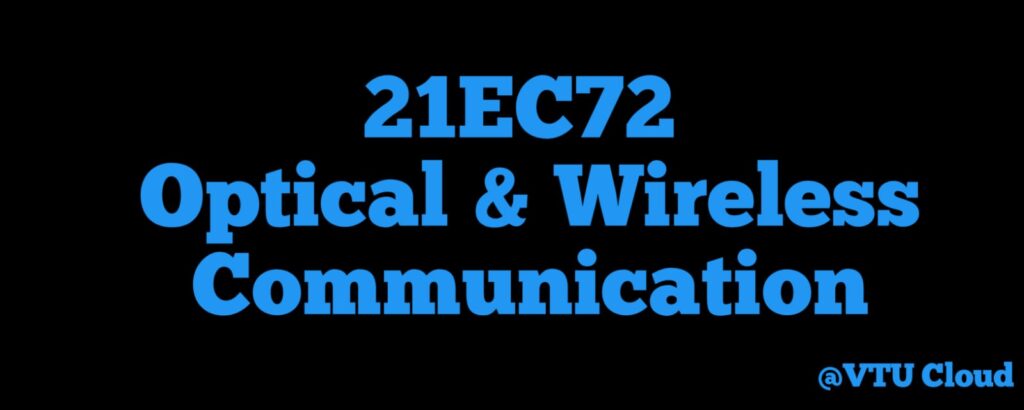21EC72 Optical and Wireless Communication

Course Learning Objectives
● Learn the basic principle of optical fiber communication with different modes of light propagation.
● Understand the transmission characteristics and losses in optical fiber.
● Study of optical components and its applications in optical communication networks.
● Understand the concepts of propagation over wireless channels from a physics standpoint
● Understand the multiple access techniques used in cellular communications standards.
● Application of Communication theory both Physical and networking to understand GSM systems that handle mobile telephony.
SYLLABUS COPY
QUESTION BANK
MODULE - 1
Optical Fiber Structures Optical Fiber Modes and Configurations, Mode theory for circular waveguides, Single mode fibers, Fiber materials.Attenuation and Dispersion Attenuation, Absorption, Scattering Losses, Bending loss, Signal Dispersion: Modal delay, Group delay, Material dispersion
MODULE - 2
Optical Sources and detectors Light Emitting Diode: LED Structures, Light source materials, Quantum efficiency and LED power, Laser Diodes: Modes and threshold conditions, Rate equations, External quantum efficiency, Resonant frequencies, Photodetectors: The pin Photodetector, Avalanche Photodiodes.WDM Concepts Overview of WDM, Isolators and Circulators, Fiber grating filters, Dielectric thin-film filters, Diffraction Gratings
MODULE - 3
Mobile Communication Engineering Wireless Network generations, Basic propagation Mechanisms, Mobile radio Channel. Principles of Cellular Communications Cellular terminology, Cell structure and Cluster, Frequency reuse concept, Cluster size and system capacity, Frequency Reuse Distance, Cochannel Interference and signal quality.
MODULE - 4
Multiple Access Techniques FDMA, TDMA, CDMA, SDMA, Hybrid Multiple Access Techniques, Multicarrier Multiple Access Schemes. A Basic Cellular System A basic cellular system connected to PSTN, Parts of basic cellular system, Operation of a cellular system.
MODULE - 5
Global System for Mobile (GSM) GSM Network Architecture, GSM signalling protocol architecture, Identifiers used in GSM system, GSM Channels, Frame structure for GSM, GSM Call procedures, GSM hand-off Procedures, GSM Services and features.
Course outcome
1. Classification and characterization of optical fibers with different modes of signal propagation.
2. Describe the constructional features and the characteristics of optical fiber and optical devices used for signal transmission and reception.
3. Understand the essential concepts and principles of mobile radio channel and cellular communication.
4. Describe various multiple access techniques used in wireless communication systems.
5. Describe the GSM architecture and procedures to establish call set up, call progress handling and call tear down in a GSM cellular network.
Suggested Learning Resources
Text Books : 1. Gerd Keiser, Optical Fiber Communication, 5 Edition, McGraw Hill Education (India) Private Limited, 2016.
2. T L Singal, Wireless Communications, McGraw Hill Education (India) Private Limited, 2016. Reference Books : 1. John M Senior, Optical Fiber Communications, Principles and Practice, 3 Edition, Pearson Education, 2010,
2. Theodore Rappaport, Wireless Communications: Principles and Practice, 2 Edition, Prentice Hall Communications Engineering and Emerging Technologies Series, 2002,
3. Gary Mullet, Introduction to Wireless Telecommunications Systems and Networks, First Edition, Cengage Learning India Pvt Ltd., 2006,